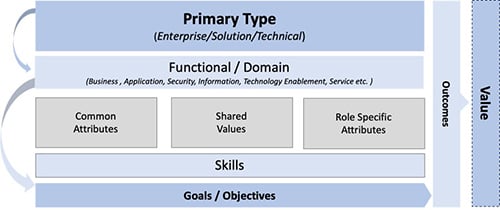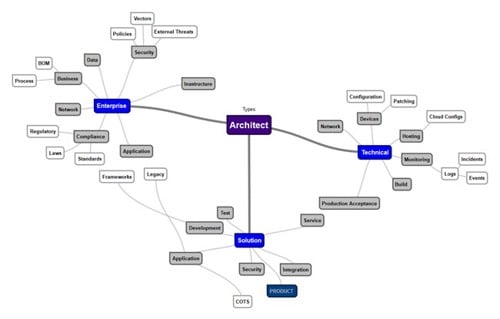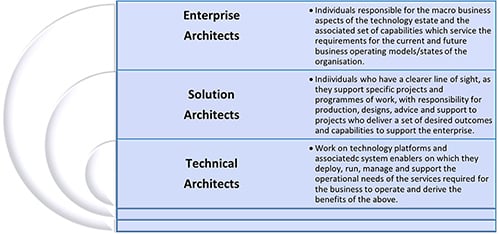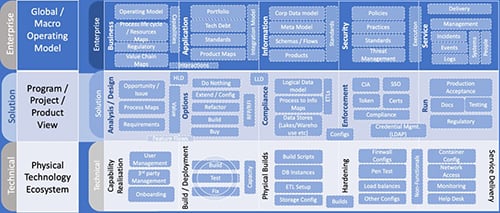Daljit Banger CITP FBCS introduces and describes three core architectural types that each spawn one or more functional roles, that when combined facilitate the support and delivery of ICT services to an organisation.
Before we introduce the basic types of architecture roles, it may be prudent to highlight how systems architecture encapsulates a wide set of information communication technology (ICT) disciplines, and that role/s may be performed by an individual or a group of individuals (a team) which is relevant to the size of the organisation and its complexity in the technology estate. However, the goals, irrelevant of size of funding, remain the same i.e. the provision of IT capabilities to meet and support the current and future business or project needs.
Architecture has always been synonymous with the design and construction of buildings. However, the IT community adopted this term to describe individuals whose primary objectives are centred around the design, build and support of information systems. This term, architect, independent of the selected architectural framework, is now appended to many roles within IT functions, particularly those previously associated with subject matter experts.
Across all the types of architects (Enterprise, Solution and Technical) we observe common attributes (system related), shared values and where appropriate role specific skills.

Fig 1. Role Capabilities mapped to Value
However, this classification supports an indirect macro activity control mechanism when considering functional activities that are found in the architecture community and drive desired ICT outcomes.
The appending of the term architect to many ICT roles has left a slight confusion in which the greatest challenge faced by the architecture community now is uniformity, or rather the lack of it i.e. in terms of definition, something that becomes apparent when one reviews requirements for roles.
We observe regular inconsistencies arising due to the lack of understanding or clarity for the required skills for similar ‘high level’ named roles e.g. when recruiting a Solution Architects one organisation may require a set of hosting skills such as AWS/Azure and another may require .Net or JEE coding skills but both specify a requirements for a Solution Architect however are fundamentally different roles where one requires network, software / service configuration skills and the other software development skills. This macro naming may appear confusing and is not limited to Solution Architects as this also appears in the Enterprise Architecture space.
One can argue that confusion will always arise when roles are defined broadly yet require specific functional skills documented are referenced especially where classification use, as with most things, can be perceived as subjective depending on one’s architectural perspective. However, all system related architecture roles do fall into one of these three high levels depicted in figure 2 below.
Fig 2. Three Primary Architectural Types (click to view larger image)
The above Architectural types can further dissected into functional operational enabling the subdivision by specialist skills and more importantly the deliverables at each level e.g. at the Enterprise level one will find multiple functional disciplines e.g. Security, Information or Service Architects - each maintaining a macro perspective (inward and outward looking of the organisation).
Further examples are depicted in figure 3 below with potential areas of activities in each domain presented for illustrative purposes only;
Fig 3. Example - Architects divided into activities / deliverables (click to view larger image)
As depicted in figure 3 many artifacts will spread over multiple functional areas e.g. you may find a High-Level Design (HLD) produced by Solution Architects both in the Solution and Compliance functions and highlighted further by examining each of the types further.
It must be noted that presented below is the high level types which expanded for domain or functional specific needs.
Enterprise Architects (Systems)
Enterprise Architects focus on the “big picture” control activities, in which they seek to mould, shape, lead, and support the organisation’s Enterprise Systems Architecture. At a minimum, this requires understanding of multiple internal and external drivers which impact the current and target Business Operating Models and encapsulate the mapping of the business needs and future requirements to that of the technology landscape.
For you
Be part of something bigger, join BCS, The Chartered Institute for IT.
Enterprise Architects are responsible for undertaking and supporting a wide variety of organisational activities ranging from the strategic, tactical and to the operational and maintaining a consistent set of multiple views; Business, Application, Information, Security and Technology enablers.
Enterprise Architects will support governance mechanisms by working with a wide group of stakeholders promoting and specifying if required the ‘guardrails’ for projects. This activity seeks to ensure projects do not consider technologies that deviate from defined target state architectures.
Solution and Technical Architects are charged to support the EA by using the defined standards and policies within projects and programmes, to ensure that any deviations from defined reference models and previously defined services are reused.
Typical activities performed across the Enterprise Architect stream, while not exhaustive, can be summarised as:
- Awareness and control of any impact from the introduction of new technology into the technology landscape of the organisation.
- Strategic delivery of technology roadmaps, budget forecast that shape, form and stabilise the technology estate of the future.
- Facilitate and support a ‘frictionless’ route to live for producers and consumers of the IT Capabilities
- Promote re-use of software, processes and tools by working with strategic, tactical and ad-hoc business projects
- Influence decision makers on technology investment – current, future and technical debt
- Provide systems consultancy, guidance and assurance to Programmes
- Review and assure, on request, Solution Designs produced both internally and by 3rd party suppliers
- Ensure all compliance obligations and system controls are managed.
- Deliver and ensure that governance mechanisms such as review boards, principles, etc. are maintained and supported to meet the desired outcomes.
- Police standards adoption in Project and Programme.
- Represent the organisation with 3rd parties, for example Systems Integrators and Standards bodies
- Protect the Enterprise assets ensuring they deliver value for the organisation.
Solution Architects
Solution Architects work programmes and projects to deliver new, improved processes supported by the relevant IT capabilities. Solution Architects must deliver the designs and processes which address a specific business or technical where solution IS designed, costed, procured, built and delivered into the organisation’s ecosystem.
Solution Architects address a wide spectrum of problems and issues ranging from the simple to the complex and thus require a wide range of skills (technical / business) and should not be confused with product architects whose skills centre around a specific product or suite of software applications which adopt and promote a vendor best practices for deployment.
The work of the Solution Architect can be broken down into the following distinct stages and categorised into the following focal areas below;
- Assistance with problem Identification / clarification
- Contextualising and visualising problems or support material for bids
- Eliciting and validating requirements (functional / non-functional)
- Designing High-Level and Low-Level Solution Design when required.
- Supporting development efforts by promoting re-usable patterns and promoting best practices within projects.
- Working with projects to deliver a route for the solution into live production environments
- Assisting with the support and transition into service.
Technical Architects
Technical Architects operate at, or close to, the ‘coal face’ i.e. the technical operational layer of the organisation and work with other architects, production teams, service delivery, testing, security and others to ensure that solution designs can be realised, compliant and sustained in a production environment.
Some of the typical activities performed by the technical type architects can be summarised as:
- Delivering technical designs and standards and the associated approvals from the formal governance channels
- Awareness and assurance of the technology estate and the technology components of the organisation
- Providing technical recommendations and options based on solution designs which can cost-effectively be realised in the production environment
- Mitigating any technical risks that could occur through the introduction of new technology into the landscape of the organisation
- Providing input into the appropriate innovation funnels for the analysis of new technology
- Keeping abreast of technology trends, attending industry events to ensure product roadmaps are understood by the Solution and Enterprise Architects.
- Ensuring that production acceptance for projects is delivered and managed.
- Performing technical Impact assessments on selected technology
- Providing technical due diligence on vendor services
The three types of Architects discussed above have a specific view on the technology landscape and hence require appropriate skill sets but are not independent and are interlinked to some extent through the life cycle of analysis, design, build and deployment for ICT Capabilities. This can be netter illustrated by exploring one of the functional roles in each type e.g. an Application Architect where they deliver a set of application / support capabilities as listed below;
Information sharing
- Enterprise Application Architects will explore and manage the ‘whole application portfolio’ across the entire organisation including applications provisioned by 3rd party vendors using the Application as a Service (AaaS) model to deliver the capabilities that meet and support the Business Operating Model of the organisation and any regulatory obligations.
- Solution Application Architects focus on project specific requirements and either leverage existing applications, extend or build new application capabilities within the guidelines set by the Enterprise Application Architects and where a deviation is required needs to communicate and justify this via the relevant governance mechanisms.
- Technical Application Specialist will focus on validating, configuring and deploying new instances of the application or any new built services
The aim of this article was to introduce three primary parental types for systems architecture which in themselves spawn multiple subtypes as illustrated in figure 4 which depicts linked functional area roles in each domain, functional and technical streams.

Fig 4. Extension of Architectural Role Types
Takeaway message - If you work as someone who is responsible for the recruitment or placement of architects it may be important to note that the three types of architect exist and are in themselves, deposit having common attributes and shared skills not the ultimate description for the artefacts or services that may need to be produced to deliver a system and should prepare the requirements / specifications with the correct name type.
About the author
Daljit Banger has 38 years of Industry experience, having undertaken assignments in multiple locations across the globe on behalf of large multi-national companies and successfully managed several large professional teams of Architects and recently the author of;
“Enterprise Systems Architecture: Aligning Organisational Business Operating Models to Technology Landscapes”
ISBN-13: 979-8625585187














